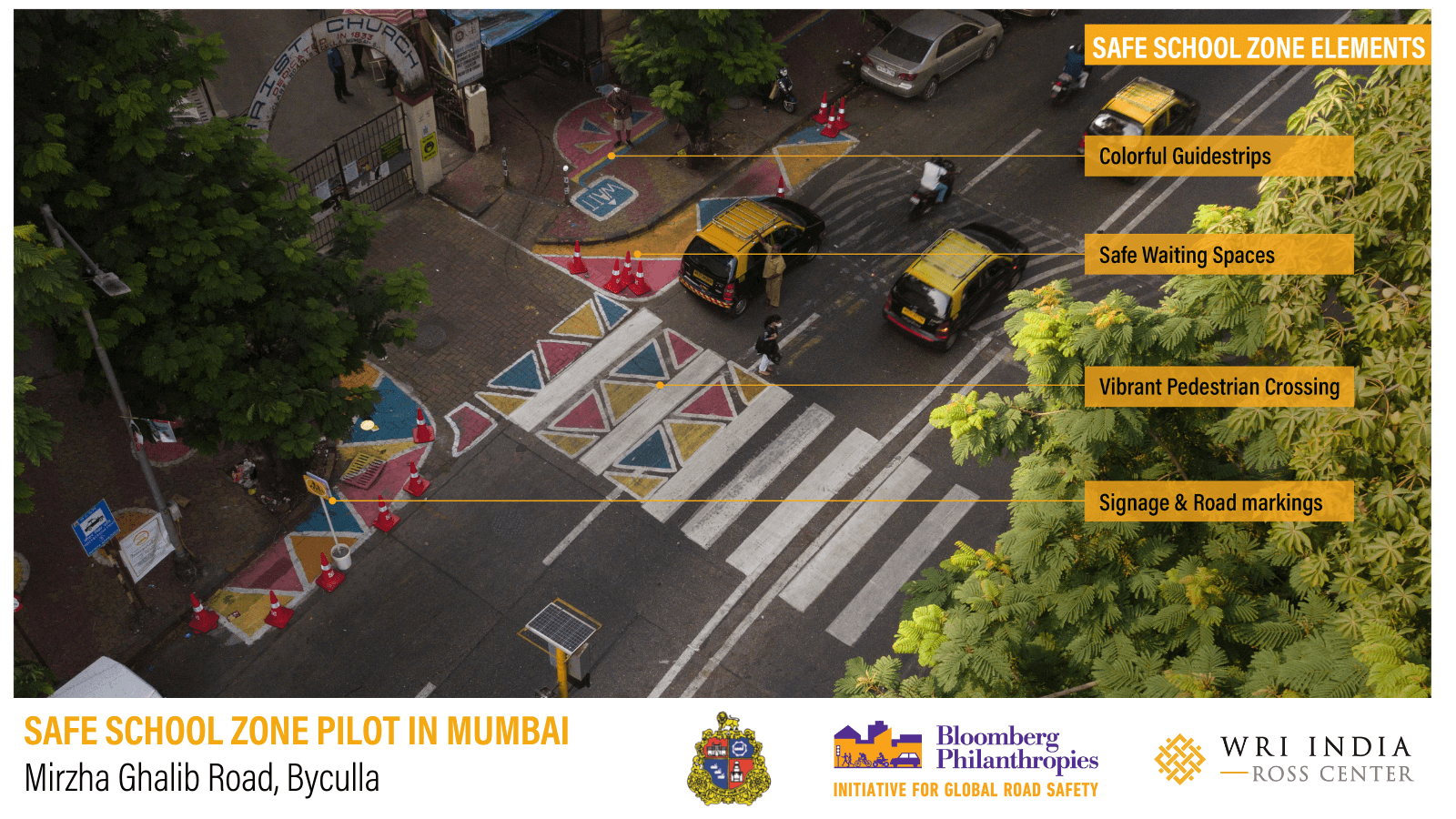- Home
- Newsroom
- Press Notes
- Mumbai gets its First Safe School Zone
Mumbai gets its First Safe School Zone

21 Oct, 2021
As schools across the country re-open after a year and a half, Mumbai Traffic Police, MCGM with technical support from WRI India, along with local citizens and experts make way for safer, vibrant, walkable child-friendly streets in Mumbai
Mumbai, October 21, 2021: The Municipal Corporation of Greater Mumbai (MCGM) and Traffic Police, in partnership with World Resources Institute (WRI) India Ross Centre has initiated a trial for the city’s first ‘Safe School Zone’ at Byculla’s Mirza Ghalib Road.
The ‘Safer Access to Schools’ project was undertaken under the Bloomberg Philanthropies Initiative for Global Road Safety (BIGRS). It aims to create child-friendly and walkable school zones in Mumbai. The trial includes testing design solutions that make the road walkable, barrier-free, safer, and more vibrant for all road users, especially children.
On Wednesday, Mumbai Traffic Police, MCGM, experts and local citizens came together to initiate the trial using paint, barricades and cones. The design solutions include demarcation of the school zone using signages, road markings, providing designated areas for walking and waiting, multi-utility zones including pick-up and drop-off zones, child-friendly spaces with playful elements and a vibrant pedestrian crossing. The trial using low-cost material will aid in undertaking feedback from the neighbourhood, before making it permanent on-ground.
Rais Shaikh, local corporator from the Samajwadi Party (SP) said, “While we work hard to provide quality education to students and improve infrastructure inside schools, it is also important to look at safer access to schools. In Mumbai, even if the school is at a walking distance, many parents/guardians take their vehicle out as it’s not safe for children to walk on these roads. This trial will showcase how making a street safer for children will make it safer for all road users.”
The Mirza Ghalib Road in the city’s E-ward (Byculla) is home to two schools – the Christ Church School and St Agnes High School. Between 2017-19, a 500-meter area around Christ Church recorded 23 crashes and three fatalities. This also included two children who suffered serious injuries while on their way back home and one student’s death. Of the 2,610 school campuses in Mumbai, 28% have witnessed more than three fatalities within a 500-meter walking radius between 2017-19.
Yogesh Kumar, Deputy Commissioner of Police (Traffic), said, “The focus here is to make the streets safer for pedestrians and by doing so, we are also looking at improving overall traffic efficiency on the road. This pilot will also make way to scale this project across Mumbai.”
Manish R Valanju, Assistant Commissioner, E-ward, said, “We will assess the trial, incorporate feedback from all the stakeholders including traffic police, school management and local community and prepare a plan for permanent implementation.”
Kelly Larson of Bloomberg Philanthropies said, "Designing streets for people and not cars, plays a critical role in increasing mobility and safety for all city residents. We are proud to partner with the Municipal Corporation of Greater Mumbai as they continue to expand efforts for safer streets and safer mobility, particularly among the most vulnerable road users - children. The Safe School Zone initiative will save lives and serve as a model for other cities throughout India."
In October 2019, WRI India had conducted a workshop with the students of Christ Church School to understand what they would like to see around their school. This included a walk around their school to understand what they like/dislike and visualization exercises where students were asked to add elements of their choice on the street. WRI India also conducted stakeholder consultations and surveys to understand the mode of commute, time spent by children in commute and the challenges they faced.
Rohit Tak, Manager, Sustainable Cities and Transport, WRI India, said, “Almost 57% of the parents had said that the streets around their school precinct is not safe for children owing to several reasons, including lack of quality footpaths and vehicular conflicts.” He added, “Children are more prone to risks compared to adults given their smaller size, cognitive development and perception of risk. Our plan looks at a safer, child-friendly street that will make their school-going journey comfortable and enjoyable.”
